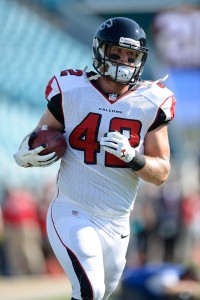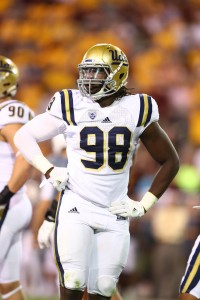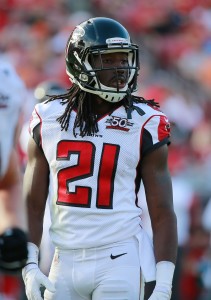The Falcons suffered the most heartbreaking loss in Super Bowl history earlier this year, blowing a 28-3 lead to the Patriots after storming through the NFC bracket. Clearly, that defeat will stick with Atlanta and its fans for some time, but that shouldn’t take away from the excellent 2016 season the club posted. With most of a high-scoring offense (except for offensive coordinator Kyle Shanahan) and a young, exciting defense returning, the Falcons’ offseason figured to be relatively quiet.
Notable signings:
- Dontari Poe, DT: One year, $8MM. $7.5MM guaranteed.
- Levine Toilolo, TE: Three years, $12MM. $4.5MM guaranteed.
- Jack Crawford, DE: Three years, $9.9MM. $3MM guaranteed.
- Matt Schaub, QB: Two years, $9MM. $2.5MM guaranteed.
- Kemal Ishmael, S: One year, $2MM. $1MM guaranteed.
- Andre Roberts, WR: One year, $1.8MM. $750K guaranteed. $500K available via incentives.
- LaRoy Reynolds, LB: One year, $1.3MM. $250K guaranteed.
- Courtney Upshaw, DL: One year, $1.15MM. $150K guaranteed. $200K available via incentives.
- Taylor Gabriel, WR: One year, $2.746MM. Signed second-round RFA tender.
- Derrick Coleman, FB: One year, $690K.
- Blidi Wreh-Wilson, CB: One year, minimum salary benefit.
Boasting one of the more complete rosters in the NFL, the Falcons didn’t have many areas of weakness to be addressed during the free agent period. Ameliorating their run defense was one such focal point, however, as Atlanta ranked 28th in DVOA against the run. In a market where Calais Campbell and Brandon Williams received more than $20MM in full guarantees on multi-year contracts, the Falcons declined to overpay and landed Dontari Poe on a one-year, $8MM deal.
Poe certainly has his positive attributes: he’s young (26), durable (just two career missed games), athletic despite his 6’3″, 250-pound stature, and can rush the passer from the interior. But it’s unclear just how helpful Poe will be at stopping the run. Among 115 qualified interior defenders, Poe graded 87th in run defense, according to Pro Football Focus. The Chiefs, Poe’s former employer, ranked 30th in total adjusted line yards last season and dead last in yards middle of their defensive line. That’s not to place all the blame at Poe’s feet, but he played the most snaps of any Kansas City defensive lineman in 2016.
While the Poe signing was certainly defensible, Atlanta’s addition of former Cowboys defensive end Jack Crawford made little sense, at least at the required price. While he did an admirable job guiding Clarice Starling in her encounters with Hannibal Lecter, Crawford doesn’t provide much that the Falcons defensive line didn’t already have. He’s a remarkably similar player to incumbent options Adrian Clayborn and Courtney Upshaw, the latter of whom also re-signed with Atlanta this offseason. Crawford isn’t as talented as either of those players, however, and at a cost of $3.3MM annually, he’s earning a similar salary to that of Erik Walden, Connor Barwin, and Julius Peppers, all of whom I’d take over Crawford.
The Falcons didn’t need to add much to an offense that ranked first in DVOA last year, but they did bring back two key insurance pieces: quarterback Matt Schaub and tight end Levine Toilolo. Now in his second stint as a backup in Atlanta, Schaub attempted only three passes in relief of Matt Ryan. While he’s a capable reserve, there’s little question the Falcons’ season would go down in flames if Schaub is forced to step in for Ryan for any serious length of time. Toilolo, meanwhile, is the perfect No. 2 tight end, as he’s a willing blocker who also plays on special teams. In 2016, Toilolo played 55% of Atlanta’s offensive snaps while rookie Austin Hooper saw roughly 40% playtime. Expect those percentages to flip next season.
The only external additions made by the Falcons — wide receiver Andre Roberts and fullback Derrick Coleman — should slot in as replacements for two departed Atlanta free agents, Eric Weems and Patrick DiMarco. Roberts will likely become the primary return man for the Falcons in 2017, although his roster spot isn’t a given just yet, per Vaughn McClure of ESPN.com. Entering his eighth NFL campaign, Roberts handled 33 kickoffs and 20 punt returns for Detroit last season. Coleman, 26, was out of of the NFL in 2016 following an alleged hit-and-run, but he should see ample playing time next season, as DiMarco played the second-most offensive snaps of any fullback in the league a season ago.
Notable losses:
- Jonathan Babineaux
- Tom Compton, OL
- Chris Chester, G: Retired
- Patrick DiMarco, FB
- Dwight Freeney, DE
- Dashon Goldson, S
- Tyson Jackson, DL: Released
- Aldrick Robinson, WR
- Jacob Tamme, TE
- Sean Weatherspoon, LB
- Eric Weems, WR
- Philip Wheeler, LB
- Paul Worrilow, LB
As Jason Fitzgerald of Over the Cap explained in an excellent offseason study, the Falcons are returning the majority of the players who contributed to their Super Bowl run, as they finished 29th in the NFL in terms of percentage of snaps lost. Additionally, Atlanta finished dead last with only 3.8% quality snaps lost, which factors in the amount of departed players who went on to sign with other clubs. The entire piece is well-worth a full read, but the main takeaway is that the Falcons didn’t lose a ton from the corps that led them to an NFC Championship title.
Veteran guard Chris Chester was the only Falcons player on either side of the ball that played more than 50% of his unit’s snaps and won’t return in 2017. Chester actually never left the field when Atlanta had the ball, as he played all 1,039 offensive snaps for the Falcons last season. Although he ultimately decided to retire, Chester wasn’t in the Falcons’ 2017 plans, anyway, as the team had no interest in re-signing him. With rookie Sean Harlow still adjusting to life as a guard, Ben Garland and Wes Schweitzer are competing to take over for Chester on the right side.
The rest of the Falcons’ notable losses on the offensive side of the ball were essentially bit players, veterans who played a role but were never a focal point on Atlanta’s offensive game plan. Patrick DiMarco, was one of the league’s most-deployed fullbacks, but he still played on less than a third of the Falcons’ offensive snaps. He was replaced by Derrick Coleman for a fraction of the cost. Tight end Jacob Tamme was Atlanta’s second-leading receiver in 2015, but is still in the midst of a lengthy recovery period following shoulder surgery. And Aldrick Robinson was a serviceable deep ball threat (six catches of 20+ yards), but he’s approaching age-30 and plays the same role as Taylor Gabriel.
Along the defensive line, Atlanta bid one longtime Falcon adieu, but hasn’t made a decision on its other age-35+ defender. Defensive tackle Jonathan Babineaux had been the longest-tenured Falcon, as he’d spent the entirety of his 12-year NFL career in Atlanta, starting 133 games during that time. He’s expected to continue his career, but the Falcons made no attempt to re-sign him this spring. On the other hand, Atlanta hasn’t ruled out a reunion with defensive end Dwight Freeney, who only played on 27% of the Falcons’ defensive snaps but still finished with 18 quarterback hurries (39th in the NFL).
Atlanta’s decision to add several young linebackers over the past two seasons meant the club had no use for a trio of veteran ‘backers: Paul Worrilow, Philip Wheeler, and Sean Weatherspoon. Among that group, Wheeler played the most defensive snaps (339) while Worrilow chipped in the most on special teams (253 plays). With Deion Jones, De’Vondre Campbell, and Duke Riley now on board, the Falcons are going with youth at the second level of their defense.
Trades:
- Acquired a 2017 first-round pick (No. 25; DE Takkarist McKinley) from the Seahawks in exchange for a 2017 first-round pick (No. 31), a 2017 third-round pick (No. 95; S Delano Hill), and a 2017 seventh-round pick (No. 249; RB Chris Carson).
- Acquired a 2017 third-round pick (No. 75; LB Duke Riley), 2017 fifth-round pick (No. 149; CB Damontae Kazee), and a 2017 fifth-round pick (No. 156; RB Brian Hill) from the Bills in exchange for a 2017 second-round pick (No. 63; OL Dion Dawkins).
Draft picks:
- 1-25: Takkarist McKinley, DE (UCLA)
- 3-75: Duke Riley, LB (LSU)
- 4-136: Sean Harlow, OL (Oregon State)
- 5-149: Damontae Kazee, CB (San Diego State)
- 5-156: Brian Hill, RB (Wyoming)
- 5-174: Eric Saubert, TE (Drake)
The Falcons had one of the league’s smallest draft classes, as they were one of only six clubs with fewer than six choices — but they made the picks count, specifically targeting areas of need and focusing in on particular players. On Day 1, Atlanta traded up in to acquire UCLA’s Takkarist McKinley in an attempt to find another edge rusher to pair with Vic Beasley. While Beasley led the league with 15.5 sacks in 2016, he managed only 16 quarterback knockdowns, leading to a 96.9% sack-per-knockdown rate that ranks second-highest over the past five seasons, according to Bill Barnwell of ESPN.com.
With Beasley likely to regress to the mean, the Falcons need more help on the edge, especially given that they rarely blitz. Atlanta will have a new defensive coordinator in 2017, but last year it rushed only four defenders 74.7% of the time, third-most in the NFL, per the 2017 Football Outsiders Almanac. McKinley has a “relatively raw approach and skill set,” says Lance Zierlein of NFL.com, but also boasts an excellent motor. While McKinley’s measurables aren’t all that impressive — he wasn’t a 2017 Force Player and ranked just 30th in SPARQ score among edge rushing prospects — it wouldn’t be surprise if he’s able to rack up sacks during his rookie season as opposing offensive linemen focus on other Atlanta defenders.
Duke Riley is the second LSU linebacker to be drafted by the Falcons in as many years, but he (and his 4.58 speed) will likely spend 2017 on special teams. Atlanta only played three-linebacker packages 19% of the time last season, so unless Riley usurps De’Vondre Campbell to play alongside Deion Jones in base sets, he may not see the field much. Likewise, offensive lineman Sean Harlow hasn’t even been mentioned as a contender for the Falcons’ right guard job, while Damontae Kazee and Brian Hill are buried on the depth chart thanks to Atlanta’s depth at cornerback and running back, respectively.
Extensions and restructures:
- Devonta Freeman, RB: Extended through 2022. Five years, $41.25MM. $17.3MM guaranteed.
- Desmond Trufant, CB: Extended through 2022. Five years, $68.75MM. $20.776MM guaranteed.
- Ryan Schraeder, T: Restructured contract. Created $4.8MM in cap space by converting 2017 $6MM roster bonus into signing bonus.
While the merits of signing running backs to long-term contracts can be debated, Devonta Freeman is exactly the type of back who deserves to be paid if a club decides its going to ink a runner for several seasons. Since becoming a full-time starter in 2015, Freeman leads NFL running backs in approximate value (Pro Football Reference’s catch-all metric), and has reached 1,500 total yards and 13 total touchdowns in both campaigns. He’s now the league’s highest-paid running back on a multi-year deal (trailing only the franchise-tagged Le’Veon Bell), and his extension almost assuredly means fellow back Tevin Coleman will leave Atlanta when his contract expires following the 2018 season.
Freeman wasn’t the only player the Falcons extended through 2022 this offseason, as the club also locked up cornerback Desmond Trufant, making the fifth-year defensive back the NFL’s fifth-highest paid corner on a multi-year pact. Trufant missed the final six games of the regular season plus Atlanta’s postseason run with a pectoral injury, but the Falcons clearly feel that he’ll rebound to full health. Pro Football Focus ranked Truant as the league’s No. 32 cornerback in 2016, the lowest mark of his career.
Atlanta has several more extension candidates on the horizon, including quarterback Matt Ryan and left tackle Jake Matthews, each of whom is signed through 2018. Franchise owner Arthur Blank has indicated a willingness to make Ryan the highest-paid player in the league, which means Ryan could be earning close to $30MM by the time talks wrap up. The Falcons are already tight on 2018 cap space, however, as their ~$9MM ranks sixth from the bottom.
Other:
- Hired Steve Sarkisian as offensive coordinator to replace Kyle Shanahan.
- Promoted Marquand Manuel to defensive coordinator to replace Richard Smith.
- Exercised 2018 fifth-year option for T Jake Matthews ($12.496MM).
- Learned CB Jalen Collins would be suspended 10 games (PEDs).
- Signed 21 undrafted rookie free agents.
While continuity has defined the Falcons’ offseason from a personnel standpoint, Atlanta is replacing both of its coordinators in 2016. New DC Marquand Manuel was promoted from within, so the club’s defensive strategies may not change all that much, but new OC Steve Sarkisian was hired from the college ranks, as he’ll replace Kyle Shanahan after one season with Alabama. Atlanta has an extremely defined offensive scheme and notable tendencies, such as their repeated use of play-action (27% of offensive plays, first in the NFL). Sarkisian doesn’t need to alter the offense after the Falcons boasted the league’s best offense in 2016, but he’ll certainly add his own ingredients to the mix.
Top 10 cap charges for 2017:
- Matt Ryan, QB: $23,750,000
- Julio Jones, WR: $13,900,000
- Robert Alford, CB: $9,600,000
- Alex Mack, C: $9,050,000
- Dontari Poe, DT: $8,000,000
- Mohamed Sanu, WR: $7,400,000
- Andy Levitre, G: $6,625,000
- Adrian Clayborn, DE: $5,406,250
- Jake Matthews, T: $5,227,568
- Brooks Reed, DE: $5,040,000
The NFC South is possibly the NFL’s strongest division, as the Panthers, Saints, and Buccaneers all have legitimate postseason hopes in 2016. The Falcons are defending champions, however, and have as good a chance as any other club in the division to take the crown. While Atlanta’s offense could certainly regress towards the mean, the Falcons’ defense could take a step up under Dan Quinn & Co. Double-digit wins and a division title should be the immediate goal for Atlanta, with a Super Bowl appearance (and a win this time) ranking as the team’s ultimate aspiration.
Information from Over the Cap and Roster Resource was used in the creation of this post. Photos courtesy of USA Today Sports Images.

Good stuff.. I didn’t realize they got so much to move out of the 2nd round from the Bills